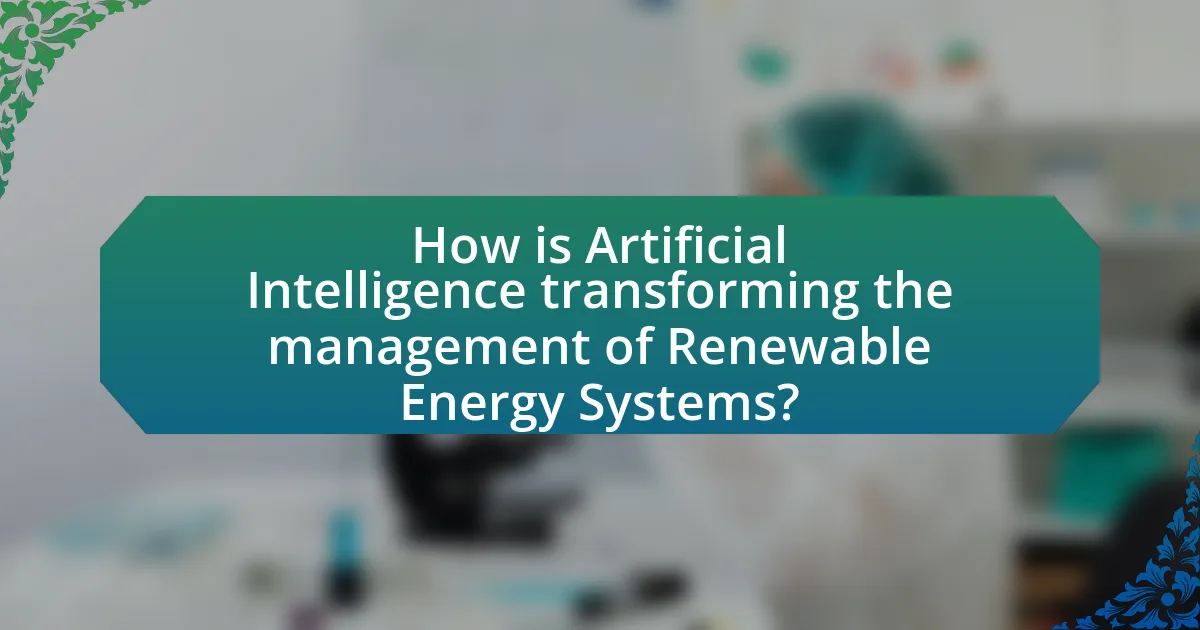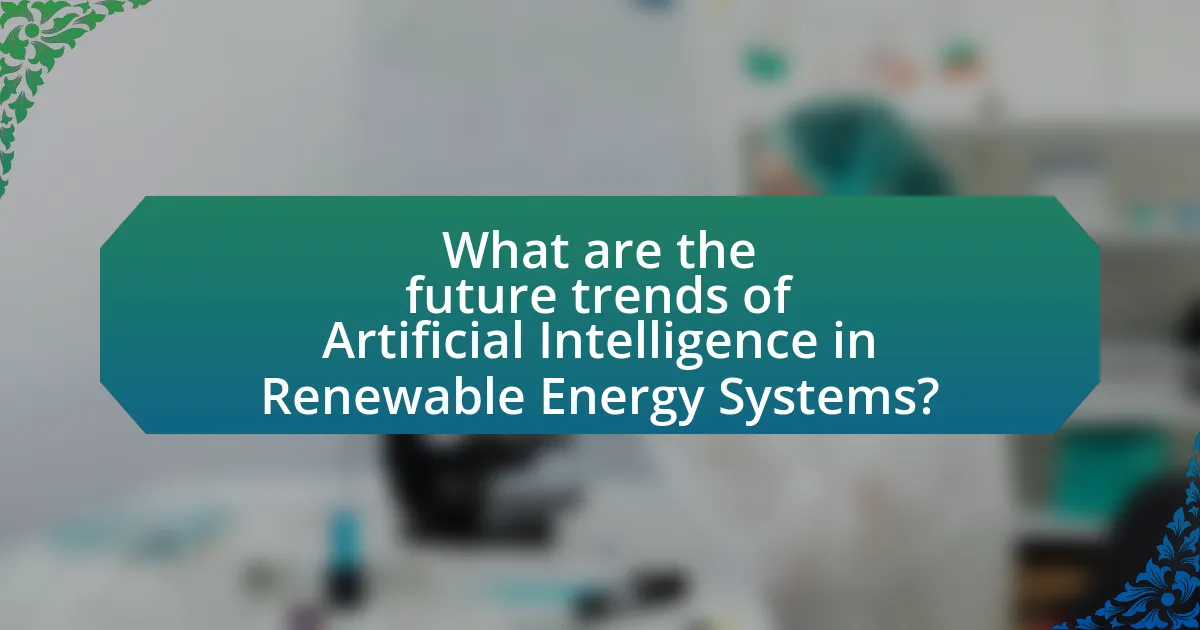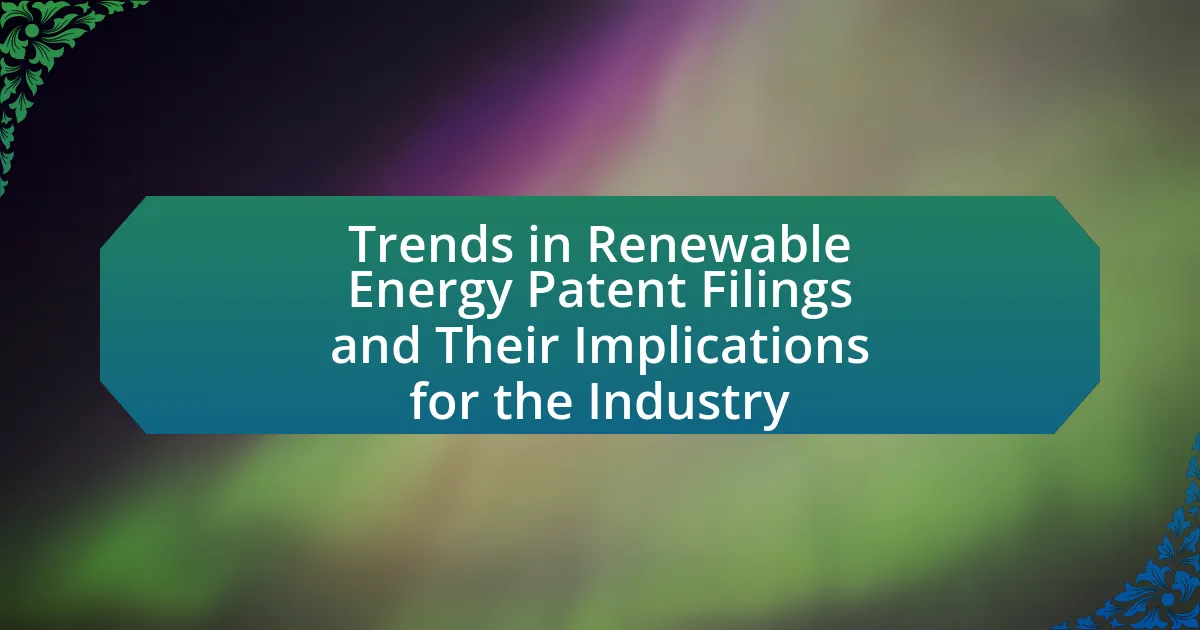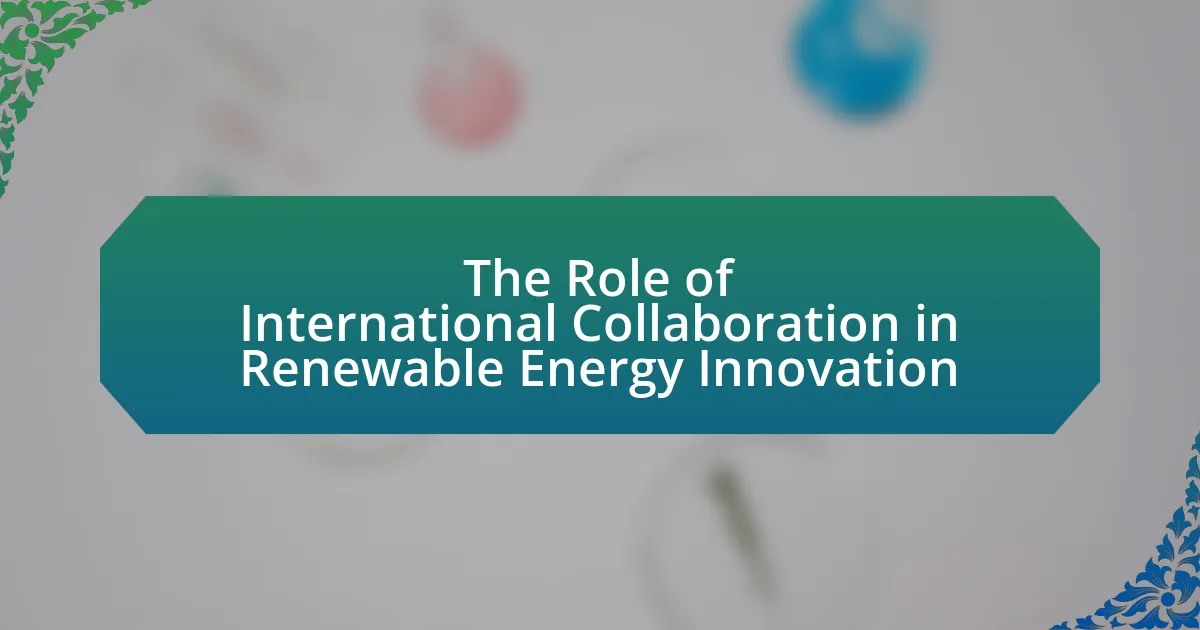Artificial Intelligence (AI) plays a pivotal role in optimizing Renewable Energy Systems by enhancing efficiency, predictive maintenance, and energy management. The article explores how AI algorithms analyze extensive data from renewable sources, such as solar and wind, to accurately forecast energy production and demand, leading to improved grid reliability and reduced energy waste. Key applications of AI include predictive maintenance, energy management, and optimization of energy production, which collectively contribute to significant operational cost reductions and increased efficiency. Additionally, the article discusses the algorithms commonly used in AI, the benefits of integrating AI into energy systems, and future trends that will further enhance the management of renewable energy resources.

What is the role of Artificial Intelligence in optimizing Renewable Energy Systems?
Artificial Intelligence plays a crucial role in optimizing Renewable Energy Systems by enhancing efficiency, predictive maintenance, and energy management. AI algorithms analyze vast amounts of data from renewable sources, such as solar and wind, to forecast energy production and demand accurately. For instance, machine learning models can predict solar energy output based on weather patterns, improving grid reliability and reducing energy waste. Additionally, AI facilitates real-time monitoring and diagnostics of renewable energy systems, allowing for timely maintenance and minimizing downtime. Studies have shown that integrating AI in energy systems can lead to a 10-20% increase in efficiency, demonstrating its significant impact on optimizing renewable energy operations.
How does Artificial Intelligence contribute to the efficiency of Renewable Energy Systems?
Artificial Intelligence enhances the efficiency of Renewable Energy Systems by optimizing energy production, consumption, and management. AI algorithms analyze vast amounts of data from renewable sources, such as solar and wind, to predict energy output and adjust operations accordingly. For instance, machine learning models can forecast solar energy generation based on weather patterns, improving grid integration and reducing reliance on fossil fuels. According to a study published in the journal “Renewable and Sustainable Energy Reviews,” AI applications in energy management can lead to a 10-20% increase in efficiency by optimizing resource allocation and minimizing waste. This demonstrates that AI not only streamlines operations but also contributes significantly to the sustainability goals of renewable energy systems.
What algorithms are commonly used in AI for optimizing energy production?
Common algorithms used in AI for optimizing energy production include genetic algorithms, neural networks, and reinforcement learning. Genetic algorithms are employed to evolve solutions for complex optimization problems by mimicking natural selection processes. Neural networks, particularly deep learning models, analyze large datasets to predict energy demand and optimize production schedules. Reinforcement learning algorithms enable systems to learn optimal strategies for energy management through trial and error, improving efficiency over time. These algorithms have been validated in various studies, demonstrating their effectiveness in enhancing energy production efficiency and integrating renewable sources into existing grids.
How does AI analyze data from renewable energy sources?
AI analyzes data from renewable energy sources by employing machine learning algorithms to process and interpret large datasets generated from these sources. These algorithms can identify patterns, predict energy production, and optimize resource allocation by analyzing variables such as weather conditions, energy demand, and system performance. For instance, a study by the National Renewable Energy Laboratory found that AI can improve solar energy forecasting accuracy by up to 30%, enabling better integration of solar power into the grid. This capability enhances the efficiency and reliability of renewable energy systems, ultimately supporting the transition to sustainable energy solutions.
What are the key benefits of integrating AI into Renewable Energy Systems?
Integrating AI into Renewable Energy Systems enhances efficiency, optimizes resource management, and improves predictive maintenance. AI algorithms analyze vast datasets to forecast energy production and consumption patterns, leading to better grid management and reduced operational costs. For instance, a study by the International Renewable Energy Agency (IRENA) found that AI can increase the efficiency of solar energy systems by up to 20% through improved forecasting and real-time adjustments. Additionally, AI-driven predictive maintenance can reduce downtime by identifying potential failures before they occur, thus ensuring a more reliable energy supply.
How does AI improve energy management and distribution?
AI improves energy management and distribution by optimizing grid operations, enhancing demand forecasting, and facilitating real-time monitoring. For instance, AI algorithms analyze vast datasets from smart meters and sensors to predict energy consumption patterns, allowing utilities to adjust supply dynamically. According to a report by the International Energy Agency, AI can increase energy efficiency by up to 20% in various sectors by enabling better load balancing and reducing peak demand. Additionally, AI-driven predictive maintenance helps identify potential equipment failures before they occur, minimizing downtime and operational costs.
What impact does AI have on reducing operational costs in renewable energy?
AI significantly reduces operational costs in renewable energy by optimizing resource management and enhancing predictive maintenance. For instance, AI algorithms analyze vast datasets from renewable energy sources, such as wind and solar, to forecast energy production more accurately, leading to better grid management and reduced energy waste. According to a report by the International Renewable Energy Agency (IRENA), AI can lower operational costs by up to 20% through improved efficiency and reduced downtime. Additionally, AI-driven predictive maintenance minimizes unexpected equipment failures, further decreasing maintenance costs and extending the lifespan of renewable energy assets.

How is Artificial Intelligence transforming the management of Renewable Energy Systems?
Artificial Intelligence is transforming the management of Renewable Energy Systems by enhancing efficiency, predictive maintenance, and energy forecasting. AI algorithms analyze vast datasets from renewable sources, such as solar and wind, to optimize energy production and consumption. For instance, machine learning models can predict energy output based on weather patterns, improving grid reliability and reducing waste. According to a report by the International Renewable Energy Agency, AI can increase the efficiency of renewable energy systems by up to 30%, demonstrating its significant impact on energy management.
What specific applications of AI are used in Renewable Energy Systems?
AI is applied in renewable energy systems primarily for predictive maintenance, energy management, and optimization of energy production. Predictive maintenance utilizes machine learning algorithms to analyze data from equipment sensors, enabling early detection of potential failures, which can reduce downtime and maintenance costs. Energy management systems leverage AI to forecast energy demand and supply, optimizing the integration of renewable sources like solar and wind into the grid. Additionally, AI algorithms optimize energy production by adjusting operational parameters in real-time based on weather forecasts and historical performance data, enhancing overall efficiency. These applications demonstrate AI’s critical role in improving the reliability and efficiency of renewable energy systems.
How does predictive maintenance enhance the reliability of renewable energy sources?
Predictive maintenance enhances the reliability of renewable energy sources by utilizing data analytics and machine learning to anticipate equipment failures before they occur. This proactive approach minimizes downtime and ensures continuous operation, which is critical for maintaining energy output. For instance, a study by the National Renewable Energy Laboratory found that predictive maintenance can reduce maintenance costs by up to 30% and increase equipment lifespan by 20%, thereby improving the overall reliability of wind turbines and solar panels. By analyzing historical performance data and real-time sensor information, predictive maintenance allows for timely interventions, ensuring that renewable energy systems operate efficiently and reliably.
What role does AI play in demand forecasting for renewable energy?
AI plays a crucial role in demand forecasting for renewable energy by analyzing vast datasets to predict energy consumption patterns. Through machine learning algorithms, AI can identify trends and correlations in historical data, enabling more accurate forecasts of energy demand. For instance, a study by the International Renewable Energy Agency (IRENA) found that AI-driven models can improve forecasting accuracy by up to 30%, which is essential for optimizing energy production and grid management. This enhanced precision helps energy providers adjust their supply strategies, ensuring that renewable energy sources are effectively utilized to meet consumer needs.
How does AI facilitate the integration of renewable energy into existing grids?
AI facilitates the integration of renewable energy into existing grids by optimizing energy management and enhancing grid stability. Through advanced algorithms, AI analyzes real-time data from renewable sources, such as solar and wind, to predict energy production and demand fluctuations. This predictive capability allows grid operators to balance supply and demand more effectively, reducing reliance on fossil fuels and minimizing energy waste. For instance, a study by the International Renewable Energy Agency (IRENA) indicates that AI can improve grid efficiency by up to 30% by enabling better forecasting and automated control systems.
What challenges does AI address in grid management?
AI addresses several challenges in grid management, including demand forecasting, grid stability, and integration of renewable energy sources. By utilizing machine learning algorithms, AI can analyze historical consumption data to predict future energy demand with high accuracy, which helps in optimizing resource allocation. Additionally, AI enhances grid stability by detecting anomalies and predicting potential failures in real-time, thereby reducing downtime and maintenance costs. Furthermore, AI facilitates the integration of renewable energy sources, such as solar and wind, by managing their variability and ensuring a balanced supply-demand equation, which is crucial for maintaining grid reliability.
How does AI optimize the balance between supply and demand in energy systems?
AI optimizes the balance between supply and demand in energy systems by utilizing predictive analytics and real-time data processing to forecast energy consumption and generation patterns. For instance, machine learning algorithms analyze historical consumption data, weather forecasts, and grid conditions to predict peak demand periods, allowing energy providers to adjust supply accordingly. Additionally, AI can manage distributed energy resources, such as solar panels and battery storage, by optimizing their output based on demand forecasts, thereby enhancing grid stability. Studies have shown that AI-driven demand response programs can reduce peak load by up to 20%, demonstrating its effectiveness in maintaining equilibrium in energy systems.

What are the future trends of Artificial Intelligence in Renewable Energy Systems?
Future trends of Artificial Intelligence in Renewable Energy Systems include enhanced predictive analytics, improved energy management, and increased integration of AI with IoT devices. Enhanced predictive analytics will enable more accurate forecasting of energy production and consumption, leading to optimized grid management and reduced energy waste. Improved energy management systems will leverage AI algorithms to dynamically adjust energy distribution based on real-time data, enhancing efficiency and reliability. Additionally, the integration of AI with IoT devices will facilitate smarter energy solutions, allowing for real-time monitoring and control of renewable energy sources. These trends are supported by advancements in machine learning techniques and the growing availability of big data in energy systems, which collectively drive innovation and efficiency in renewable energy management.
How will advancements in AI technology impact Renewable Energy Systems?
Advancements in AI technology will significantly enhance the efficiency and reliability of Renewable Energy Systems. AI algorithms can optimize energy production by predicting weather patterns, which allows for better integration of renewable sources like solar and wind into the energy grid. For instance, a study by the International Renewable Energy Agency (IRENA) indicates that AI can improve the forecasting accuracy of renewable energy generation by up to 30%, leading to more effective energy management and reduced reliance on fossil fuels. Additionally, AI can facilitate real-time monitoring and predictive maintenance of renewable energy infrastructure, thereby minimizing downtime and operational costs.
What emerging technologies are likely to enhance AI capabilities in energy optimization?
Emerging technologies such as edge computing, blockchain, and advanced machine learning algorithms are likely to enhance AI capabilities in energy optimization. Edge computing allows for real-time data processing closer to the source, reducing latency and improving decision-making efficiency in energy systems. Blockchain technology can provide secure and transparent energy transactions, facilitating decentralized energy management and enhancing trust in AI-driven solutions. Advanced machine learning algorithms, including deep learning and reinforcement learning, enable more accurate predictive analytics and optimization strategies, leading to improved energy efficiency and resource allocation. These technologies collectively contribute to more responsive and intelligent energy systems, optimizing renewable energy utilization.
How can AI contribute to achieving global renewable energy targets?
AI can significantly contribute to achieving global renewable energy targets by optimizing energy production, enhancing grid management, and improving energy efficiency. For instance, AI algorithms can analyze vast amounts of data from renewable sources like solar and wind to predict energy output more accurately, allowing for better integration into the energy grid. According to a report by the International Renewable Energy Agency (IRENA), AI can increase the efficiency of renewable energy systems by up to 30% through predictive maintenance and real-time monitoring. Additionally, AI-driven demand response systems can adjust energy consumption patterns based on availability, further supporting the stability and reliability of renewable energy sources.
What best practices should be followed when implementing AI in Renewable Energy Systems?
Best practices for implementing AI in Renewable Energy Systems include ensuring data quality, integrating AI with existing infrastructure, and prioritizing transparency in AI decision-making processes. High-quality data is crucial, as accurate predictions and optimizations depend on reliable input; for instance, the International Renewable Energy Agency emphasizes that data-driven insights can enhance operational efficiency. Integration with existing systems allows for seamless operation and maximizes the benefits of AI technologies, as demonstrated by successful projects in smart grid management. Transparency in AI algorithms fosters trust and accountability, which is essential for stakeholder engagement and regulatory compliance, as highlighted by the European Commission’s guidelines on AI ethics.
How can organizations ensure data quality for effective AI optimization?
Organizations can ensure data quality for effective AI optimization by implementing rigorous data governance frameworks that include data validation, cleansing, and continuous monitoring processes. These frameworks help maintain accuracy, consistency, and reliability of data, which are critical for AI algorithms to function optimally. For instance, a study by the MIT Sloan Management Review found that organizations with strong data governance practices experience a 20% increase in data quality, leading to improved AI performance. By prioritizing these practices, organizations can significantly enhance the effectiveness of AI in optimizing renewable energy systems.
What strategies can be employed to overcome barriers to AI adoption in renewable energy?
To overcome barriers to AI adoption in renewable energy, organizations can implement strategies such as enhancing data infrastructure, fostering collaboration among stakeholders, and investing in education and training. Enhancing data infrastructure ensures that high-quality, accessible data is available for AI algorithms, which is crucial for accurate modeling and decision-making. Collaboration among stakeholders, including government, industry, and academia, can facilitate knowledge sharing and resource pooling, leading to more effective AI solutions. Investing in education and training equips the workforce with the necessary skills to leverage AI technologies, addressing the skills gap that often hinders adoption. These strategies are supported by studies indicating that improved data management and collaborative frameworks significantly increase the successful integration of AI in energy systems.




